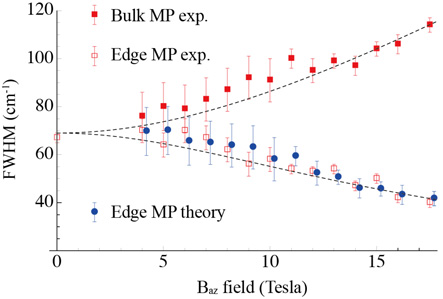Determination of Intrinsic Lifetime of Edge Magnetoplasmons
Many types of intriguing phenomena can emerge at the edge of a material that are invisible or hiding in the interior for some reason. Edge magnetoplasmon is such an example; it is a gapless collective excitation that appears at the edge of a two-dimensional electron gas (2DEG) under the application of an external magnetic field [1]. The properties unique to the edge magnetoplasmons, such as the localization length and dispersion relation, were calculated by Volkov and Mikhailov [2]. They succeeded in solving an integral equation of the electric potential using the Wiener-Hopf method. Meanwhile, an internal magnetic field, which is coupled to the potential through Maxwell equations, is neglected, and this simplification prevents the lifetime of the edge magnetoplasmon from being determined and also obscures the magnetic configurations of the excitations. The fact that the localization length and dispersion relation are dependent on the lifetime makes it difficult to analyze experimental results.
In Ref. [3], we determine the intrinsic lifetime of the edge magnetoplasmon. Our analyses are based on two observations. The first is that there is a purely relaxational state with a very long lifetime in the interior of a 2DEG. The second is that the state acquires a non-zero real part of the frequency through localization and starts to propagate. By showing that the properties of the localized state are consistent with those of the edge magnetoplasmons, we identified the purely relaxational state as the bulk counterpart of the edge magnetoplasmons and determined the lifetime of the edge magnetoplasmons (Fig. 1). Our results show that the internal magnetic field normal to the layer is strongly suppressed in the interior, which partly justifies the assumption used in the past and may lead us to a more complete description of the edge magnetoplasmons.
- [1] H. Yan, et al., Nano Lett. 12, 3766 (2012).
- [2] V. A. Volkov and S. A. Mikhailov, Sov. Phys. JETP 67, 1639 (1988).
- [3] K. Sasaki, S. Murakami, Y. Tokura, and H. Yamamoto, Phys. Rev. B 93, 125402 (2016).

|
| Fig. 1. Our result on the lifetime of edge magnetoplasmons is applied to a recent experiment reported in Ref. [1]. The close agreement between the circle and open square plots supports the validity of our result. |